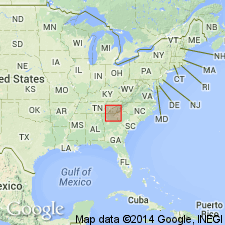
- Usage in publication:
-
- Big Butt quartzite
- Modifications:
-
- Named
- Dominant lithology:
-
- Quartzite
- Argillite
- Arkose
- AAPG geologic province:
-
- Piedmont-Blue Ridge province
- Appalachian basin
Summary:
Named as youngest formation in Ocoee series. Named for Big Butt, the northeast culmination of Bald Mountains on TN-NC State line. Consists of white, thick-bedded, granular quartzite and interbedded argillite and fine-grained arkose. On Big Butt, consists of two beds of massive quartzite, each about 30 feet thick, separated by approx. 100 feet of argillite and arkose. Northeast of Big Butt, quartzite caps Rich Mountain and, in vicinity of Nolichucky River, forms Jump Hill and caps Stony Point; at these places, quartzite is enclosed in main syncline of Ocoee series and overlies Nantahala slate. One mi southeast of Murphy, Big Butt quartzite makes prominent ridge which is cut through by Hiwassee River; in exposures on north side of river, quartzite is 200 feet thick and consists of two layers of white, thick-bedded, massive quartzite with thinner beds of white and blue, irregularly bedded quartzite in the middle. In northern part of Ellijay quad, quartzite is 500 to 600 feet thick, but thins southwestward. In Murphy syncline, Keith (1907) and La Forge and Phalen (1913) mapped a white quartzite (Tusquitee) which overlies Nantahala slate and underlies Brasstown schist and Valleytown formation. At most places, Keith mapped the quartzite in two parallel lenticular bands with anticlines of Nantahala slate between. These quartzites are herein correlated with Big Butt quartzite; interbedded slate is also part of Big Butt, not Nantahala, equivalent to argillite and arkosic quartzite on Big Butt on Bald Mountain. Keith (1905) had previously called the quartzite "Nebo quartzite" and softer beds "Murray shale"; these names should now be used only for Lower Cambrian units. Age is late Precambrian. Report includes many geologic sketch maps.
Source: GNU records (USGS DDS-6; Reston GNULEX).
For more information, please contact Nancy Stamm, Geologic Names Committee Secretary.
Asterisk (*) indicates published by U.S. Geological Survey authors.
"No current usage" (†) implies that a name has been abandoned or has fallen into disuse. Former usage and, if known, replacement name given in parentheses ( ).
Slash (/) indicates name conflicts with nomenclatural guidelines (CSN, 1933; ACSN, 1961, 1970; NACSN, 1983, 2005, 2021). May be explained within brackets ([ ]).

